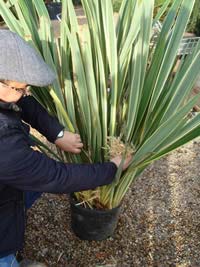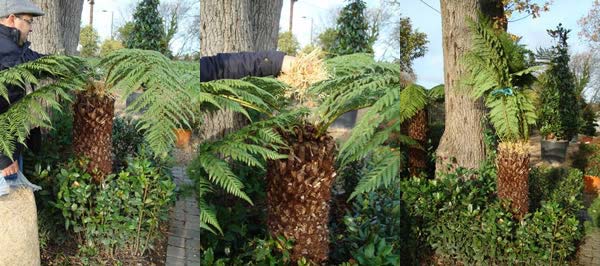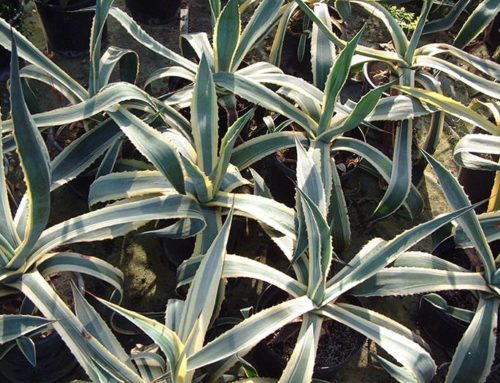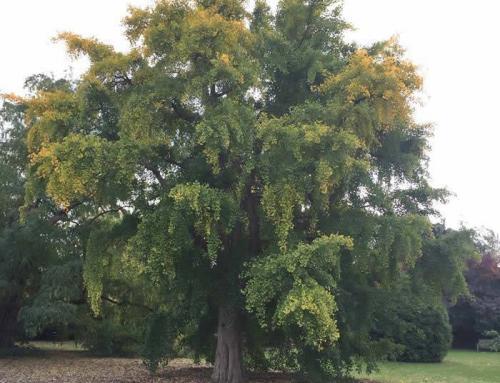We have just had one of the mildest Autumns on record but, not meaning to sound too pessimistic, I am sure things will change weather wise be it sooner or later.
The combination of complacency and the element of surprise regarding the last 2 winters meant that plants which may have been saved with protection were lost. Whether we will experience another winter as severe as the last 2 remains to be seen but it is worth taking a few precautions to give our exotics the best chance of survival.
The most noticeable victims of the worse winter in 100 years (2010) were the Cordyline Australis, Phormiums and Phoenix Palms. Many of these were large established mature plants which as a result left some very large holes. It is understandable that some people were reluctant to replace these plants when they could be killed again, but this need not be the case.
Methods for Protecting Plants over the Winter Months
Cordylines
The most vulnerable part of these plants is the growing point and one of their worse enemies is snow. If long periods of snow are forecast tie the leaves up preferably in two or three places to ensure that snow or excess moisture cannot penetrate the inner part of the plant. The lower (outer) leaves will protect the inner more tender ones. During in-between periods of milder weather untie to allow air to circulate. In very cold areas you may also need to wrap the trunks of the plant with hessian or horticultural fleece.
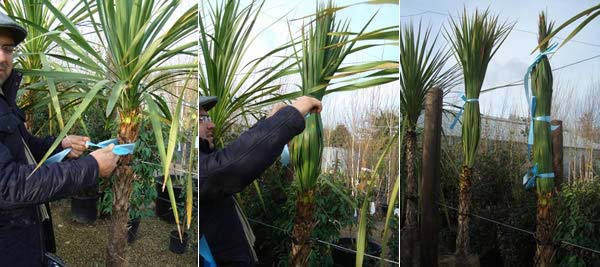
How To Protect Cordylines From Winter FrostProtecting Phormiums From Winter Frost by Packing With Straw
Phormiums
The part of these you need to protect most in very severe weather is the base. Straw is a tremendous insulator providing it is kept reasonably dry. After packing the straw around the base cover it with slates or tiles. This will stop it from blowing away and keep off the worse of the wet. It is important to tie up the leaves of phormiums because heavy snow breaks and flattens them. In very severe conditions hessian wrapped around will make a big difference for the foliage.
Incidentally even reliably hardy plants like Trachycarpus Palms in long periods of heavy snow will benefit greatly from having their leaves tied up. Light snow can be knocked off with a broom but heavy snow will weigh down and even break the leaves.
Bananas
The most tender of all hardy exotics is the Banana – Musa Basjoo. These plants are root hardy (so even if the plant dies back completely there is a good chance of it reshooting the following year if properly mulched) but if you want them to get bigger year by year you will need to protect the trunk. When the first frost is imminent first cut off all the leaves. If you plant is small you can use some thick plastic drain pipe or an old chimney pot. If the trunk is say 1.5-2m height you will need to make a tube out of chicken wire (about 18 inches diameter). Then pack the straw down around the trunk of the banana until you have reached and covered the top. If using plastic tubing all you will need to do then is cover the top with slate or tile. If chickenwire you will then need to cover the whole thing with plastic sheeting. Tie around the middle to prevent blowing away and make a few small vertical slits in the plastic to prevent condensation. Your banana will begin to sprout around late May when everything can then be removed.
Tree Ferns
As with Cordylines the part of these plants in need of protection is the crown. It is not determintal to tree ferns to lose their fronds through frost, as a complete new set of them is produced every year, usually all at once but any frost damage to the crown can kill them completely.
Simply push a few handfuls of straw down the top of the trunk where the new fronds emerge and then cover with a tile or slate to prevent the straw blowing away and to keep off the worse of the rain. If you wish to try and retain the existing fronds tie them up vertically and wrap around with hessian. In very cold areas it might also be wise to wrap the trunk in hessian as well.
Phoenix Palm
Do exactly as described for Tree Ferns but wrap the whole plant with several layers of hessian.
Gunnera Manicata (Giant Rhubarb)
It is important to protect the crowns of these plants which otherwise can be killed completely by severe frost. First cut off all the leaves and then the stalks of the leaves. Place a generous covering of straw over the crown of the plant and then turning the leaves upside down place them (beginning with the smallest) on top of each other on top of the straw. Then lay the salks of the leaves on top of them to prevent them blowing away.
Spending relatively little time and money with these precautions can ensure the survival of often large and expensive plants.
It is not just the cost involved but it is also sad to lose fine specimens which we may have had for a number of years.
We all hope of course that the mild winters that we have all become accustomed to will return but in the meantime to prevent our being disheartened we should do what we can to retain the plants we have…
PLEASE READ IN CONJUNCTION WITH OUR OTHER BLOGS INCLUDING TOP TIPS FOR MAINTAINING YOUR GARDEN
Winter Damaged Cordylines…
Top Tips for Maintaining Your Plants…

